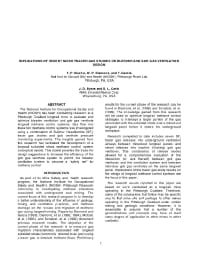Mining Publication: Implications of Recent NIOSH Tracer Gas Studies on Bleeder and Gob Gas Ventilation Design
Original creation date: February 2000
Authors: TP Mucho, WP Diamond, F Garcia, JD Byars, SL Cario
NIOSHTIC2 Number: 20021020
SME Annual Meeting, 2000 Feb 25 - Mar 1, Salt Lake City, Utah, SME Preprint No. 00-8, Littleton, CO, 2005; :1-17
The National Institute for Occupational Safety and Health (NIOSH) has been conducting research at a Pittsburgh Coalbed longwall mine to evaluate and optimize bleeder ventilation and gob gas venthole longwall methane control systems. Gas flow into these two methane control systems was investigated using a combination of Sulphur Hexafluoride (SF6) tracer gas studies and gob venthole pressure monitoring experiments. The insights gained from this research has facilitated the development of a longwall subsided strata methane control system conceptual model. This model provides the basis for design suggestions to increase the efficiency of the gob gas venthole system to permit the bleeder ventilation system to become a "safety net" for methane control.

NIOSHTIC2 Number: 20021020
SME Annual Meeting, 2000 Feb 25 - Mar 1, Salt Lake City, Utah, SME Preprint No. 00-8, Littleton, CO, 2005; :1-17
- The Borehole Monitoring Experiment: Field Measurements of Reservoir Conditions and Responses in Longwall Panel Overburden During Active Mining
- Computational Fluid Dynamics Modeling for Underground Mines
- Degasification System Selection for U.S. Longwall Mines Using an Expert Classification System
- Guidelines for the Prediction and Control of Methane Emissions on Longwalls
- Modeling and Prediction of Ventilation Methane Emissions of U.S. Longwall Mines Using Supervised Artificial Neural Networks
- Predicting Methane Emissions from Longer Longwall Faces by Analysis of Emission Contributors
- Prediction of Longwall Methane Emissions and the Associated Consequences of Increasing Longwall Face Lengths: A Case Study in the Pittsburgh Coalbed
- Prediction of Longwall Methane Emissions: An Evaluation of the Influence of Mining Practices on Gas Emissions and Methane Control Systems
- Studying Longwall Ventilation with Physical Modeling
- Technology News 448 - Improving the Performance of Longwall Gob Gas Ventholes